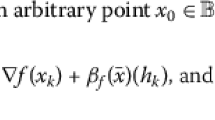Abstract
For the problem of the best approximation of several elements with respect to the maximum of convex-concave fractional functions with additional restrictions, we establish duality relations and criteria for the element of the best approximation.
Similar content being viewed by others
References
N. P. Komeichuk,Extremal Problems in the Theory of Approximation [in Russian], Nauka, Moscow (1976).
V. M. Tikhomirov,Some Problems in the Theory of Approximation [in Russian], Moscow University, Moscow (1976).
P.-J. Laurent,Approximation et Optimisation [Russian translation], Mir, Moscow (1975).
L. Collatz and W. Krabs,Approximationstheorie. Tschebyscheffsche Approximation mit Anwendungen, B. G. Teubner, Stuttgart (1973).
B. N. Pshenichnyi,Necessary Conditions of Extrenum [in Russian], Nauka, Moscow (1982).
V. O. Gnatyuk, V. V. Moiko, and Yu. V. Gnatyuk, “Basic properties of the problem of best approximation with respect to a fractional function,”Vestn. Kiev. Univ. Fiz.-Mat., Issue 2, 26–31 (1991).
A. D. Ioffe and V. M. Tikhomirov,Theory of Extremal Problems [in Russian], Nauka, Moscow (1974).
Additional information
Kamenets-Podol'skii Pedagogical Institute, Kamenets-Podol'sk. Translated from Ukrainskii Matematicheskii Zhurnal, Vol. 48, No. 9, pp. 1183–1193, September, 1996.
Rights and permissions
About this article
Cite this article
Gnatyuk, Y.V. Basic properties of the problem of the best simultaneous approximation of several elements. Ukr Math J 48, 1341–1352 (1996). https://doi.org/10.1007/BF02595356
Received:
Issue Date:
DOI: https://doi.org/10.1007/BF02595356




